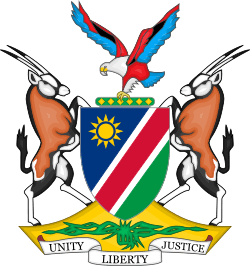National Assembly (Namibia)
The National Assembly is the lower chamber of Namibia's bicameral Parliament. Since 2014, it has a total of 104 members. 96 members are directly elected through a system of closed list proportional representation and serve five-year terms.[2] Eight additional members are appointed by the President.[3]
National Assembly | |
|---|---|
 | |
| Type | |
| Type | Lower House of the Parliament of Namibia |
| History | |
| Founded | 21 March 1990[1] |
| Leadership | |
Deputy Speaker | |
| Structure | |
| Seats | 104 |
.svg.png) | |
Political groups | Government (71) Appointed members (8) Opposition (33) NUDO (2) APP (2)
|
Length of term | 5 years |
| Elections | |
| Closed list proportional representation and appointments by the President | |
Last election | 27 November 2019 |
| Meeting place | |
| Tintenpalast, Windhoek, Khomas Region, Namibia | |
| Website | |
| Parliament of Namibia | |
 |
|---|
| This article is part of a series on the politics and government of Namibia |
|
|
|
Namibia's National Assembly emerged on Independence Day on 21 March 1990 from the Constituent Assembly of Namibia, following the elections of November 1989. That election, following guidelines established by the United Nations, included foreign observers in an effort to ensure a free and fair election process. The current National Assembly was formed following elections on 28 November 2014. Since 2015, SWAPO member Peter Katjavivi has been the Speaker of the National Assembly.[3]
2019 elections
| Party | Votes | % | Seats | +/– | |
|---|---|---|---|---|---|
| SWAPO | 536,861 | 65.5 | 63 | –14 | |
| Popular Democratic Movement | 136,576 | 16.6 | 16 | +11 | |
| Landless People's Movement | 38,956 | 4.7 | 4 | New | |
| National Unity Democratic Organisation | 16,066 | 1.9 | 2 | 0 | |
| All People's Party | 14,664 | 1.8 | 2 | 0 | |
| United Democratic Front | 14,644 | 1.8 | 2 | 0 | |
| Republican Party | 14,546 | 1.8 | 2 | +1 | |
| Namibian Economic Freedom Fighters | 13,580 | 1.7 | 2 | +2 | |
| Rally for Democracy and Progress | 8,953 | 1.1 | 1 | –2 | |
| Christian Democratic Voice | 5,841 | 0.7 | 1 | +1 | |
| SWANU | 5,330 | 0.6 | 1 | 0 | |
| Congress of Democrats | 4,645 | 0.6 | 0 | 0 | |
| National Democratic Party | 4,559 | 0.6 | 0 | 0 | |
| Workers Revolutionary Party | 3,212 | 0.4 | 0 | –2 | |
| National Patriotic Front | 1,785 | 0.2 | 0 | New | |
| Invalid/blank votes | 0 | – | – | – | |
| Total | 820,227 | 100 | 96 | – | |
| Registered voters/turnout | 1,358,468 | 60.4 | – | – | |
| Source: ECN | |||||

Previous National Assembly election results
| Political Party | Election Year | |||||||
|---|---|---|---|---|---|---|---|---|
| 1989 | 1994 | 1999 | 2004 | 2009 | 2014 | |||
| South-West Africa People's Organisation (SWAPO) | 41 | 53 | 55 | 55 | 54 | 77 | ||
| Rally for Democracy and Progress (RDP) | - | - | - | - | 8 | 3 | ||
| Popular Democratic Movement (PDM) | 21 | 15 | 7 | 4 | 2 | 5 | ||
| United Democratic Front (UDF) | 4 | 2 | 2 | 3 | 2 | 2 | ||
| National Unity Democratic Organization (NUDO) | - | - | - | 3 | 2 | 2 | ||
| Congress of Democrats (COD) | - | - | 7 | 5 | 1 | 0 | ||
| Republican Party (RP) | - | - | - | 1 | 1 | 1 | ||
| South West Africa National Union (SWANU) | - | 0 | 0 | 0 | 1 | 1 | ||
| All People’s Party (APP) | - | - | - | - | 1 | 2 | ||
| Monitor Action Group (MAG) | - | 1 | 1 | 1 | 0 | 0 | ||
| Democratic Coalition of Namibia (DCN) | - | 1 | 0 | - | - | - | ||
| Federal Convention of Namibia (FCN) | 1 | 0 | 0 | - | - | - | ||
| Action Christian National (ACN) | 3 | - | - | - | - | - | ||
| Namibia Patriotic Front (NPF) | 1 | - | - | - | - | - | ||
| Namibia National Front (NNF) | 1 | - | - | - | - | - | ||
| Total | 72 | 72 | 72 | 72 | 72 | 96 | ||
Despite being a one party dominant state since its independence in 1990, Namibian elections have been transparent, free, and largely fair.[3][4]
See also
- National Council of Namibia - the upper chamber of Parliament
- History of Namibia
- List of National Assemblies of Namibia
- List of Speakers of the National Assembly of Namibia
- Legislative Branch
- List of national legislatures
References
- https://www.parliament.na/index.php/1st-national-assembly-1990-1995
- https://data.ipu.org/content/namibia?chamber_id=13470
- "How to Register as a Voter". Electoral Commission of Namibia. Archived from the original on July 21, 2018. Retrieved March 22, 2019.
- "Namibia Rebel Group Wins Vote, But It Falls Short of Full Control". The New York Times. 15 November 1989. Retrieved 2014-06-20.